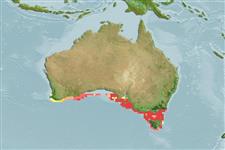>
Dactylopteriformes (Flying gurnards) >
Pegasidae (Seamoths)
Etymology: Pegasus: Taken form the winged horse of Perseus in the ancient Greek, mithology (Ref. 45335); lancifer: From the Latin word 'lancea' meaning a light spear or lance..
More on author: Kaup.
Environment: milieu / climate zone / depth range / distribution range
Écologie
marin; saumâtre démersal; profondeur 20 - 50 m (Ref. 75154). Temperate; 33°S - 45°S
Eastern Indian Ocean: endemic to the temperate waters of southern Australia and Tasmania.
Taille / Poids / Âge
Maturity: Lm ? range ? - ? cm
Max length : 9.1 cm SL mâle / non sexé; (Ref. 1418)
Description synthétique
Morphologie | Morphométrie
Épines dorsales (Total): 0; Rayons mous dorsaux (Total): 5; Épines anales 0; Rayons mous anaux: 5; Vertèbres: 22. Body light to dark brown, olive or blue dorsally and laterally, light brown ventrally. Tail rings 14, anteriormost 7 mobile, remaining 7 fused; terminal tail rings with dorsal and ventral pairs of posteriorly directed spines; rostrum square in cross section; interpectoral plate absent. 4 pairs dorsolateral body plates; 5 pairs ventrolateral body plates; suborbital shelf convex, obscuring eye from ventral view; deep pits on dorsal surface of head and within interorbital depression absent. Orbit with small scales.
A benthic species found inshore of the continental shelf in muddy, silty and sandy bottoms, usually with seagrass; intertidal to 50 m depth (Ref. 75154). Large numbers of individuals are known to congregate in the shallows of estuaries. The species is capable of burying itself in the sediment and change colors to match the background.
Life cycle and mating behavior
Maturité | Reproduction | Frai | Œufs | Fécondité | Larves
Spawning occurs as male & female swim from vent to vent, about 1 meter off the bottom, while they release eggs & sperms. The pair separates and each swims away as the eggs begin a pelagic phase.
Palsson, W.A. and T.W. Pietsch, 1989. Revision of the Acanthopterygian fish Family Pegasidae (Order Gasterosteiformes). Indo-Pac. Fish. (18):38 p. (Ref. 1418)
Statut dans la liste rouge de l'IUCN (Ref. 130435)
Menace pour l'homme
Harmless
Utilisations par l'homme
Plus d'informations
Taille/ÂgeCroissanceLongueur-poidsLongueur-longueurFréquences de longueursMorphométrieMorphologieLarvesDynamique des populations larvairesRecrutementAbondanceBRUVS
RéférencesAquacultureProfil d'aquacultureSouchesGénétiqueElectrophoresesHéritabilitéPathologiesTraitementNutrientsMass conversion
CollaborateursImagesStamps, Coins Misc.SonsCiguateraVitesseType de nageSurface branchialeOtolithesCerveauxVision
Outils
Articles particuliers
Télécharger en XML
Sources Internet
Estimates based on models
Preferred temperature (Ref.
123201): 14.6 - 18, mean 16 °C (based on 31 cells).
Phylogenetic diversity index (Ref.
82804): PD
50 = 0.5781 [Uniqueness, from 0.5 = low to 2.0 = high].
Bayesian length-weight: a=0.01000 (0.00244 - 0.04107), b=3.04 (2.81 - 3.27), in cm total length, based on all LWR estimates for this body shape (Ref.
93245).
Niveau trophique (Ref.
69278): 3.3 ±0.4 se; based on size and trophs of closest relatives
Fishing Vulnerability (Ref.
59153): Low vulnerability (10 of 100).
